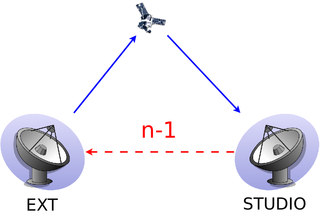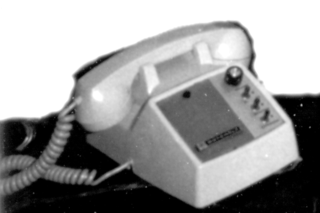
A radiotelephone, abbreviated RT, is a radio communication system for transmission of speech over radio. Radiotelephony means transmission of sound (audio) by radio, in contrast to radiotelegraphy, which is transmission of telegraph signals, or television, transmission of moving pictures and sound. The term may include radio broadcasting systems, which transmit audio one way to listeners, but usually refers to two-way radio systems for bidirectional person-to-person voice communication between separated users, such as CB radio or marine radio. In spite of the name, radiotelephony systems are not necessarily connected to or have anything to do with the telephone network, and in some radio services, including GMRS, interconnection is prohibited.

A broadcast auxiliary service or BAS is any radio frequency system used by a radio station or TV station, which is not part of its direct broadcast to listeners or viewers. These are essentially internal-use backhaul channels not intended for actual reception by the public, but part of the airchain required to get those signals back to the broadcast studio from the field. usually to be integrated into a live production.
A telecommunication circuit is a path in a telecommunications network used to transmit information.

A professional video camera is a high-end device for creating electronic moving images. Originally developed for use in television studios or with outside broadcast trucks, they are now also used for music videos, direct-to-video movies, corporate and educational videos, wedding videos, among other uses. Since the 2000s, most professional video cameras are digital professional video cameras.

Base station is – according to the International Telecommunication Union's (ITU) Radio Regulations (RR) – a "land station in the land mobile service."
A cordless telephone or portable telephone is a telephone in which the handset is portable but able to be used like landline phone communication, only it operates by radio frequency transmission and not a physical insulated wire, or telephone line. The base station is connected to the telephone network through a telephone line as a corded telephone is, and also serves as a charger to charge the handset's batteries. The range is limited, usually to the same building or some short distance from the base station.

A telephone hybrid is the component at the ends of a subscriber line of the public switched telephone network (PSTN) that converts between two-wire and four-wire forms of bidirectional audio paths. When used in broadcast facilities to enable the airing of telephone callers, the broadcast-quality telephone hybrid is known as a broadcast telephone hybrid or telephone balance unit.
In broadcast engineering, a remote broadcast is broadcasting done from a location away from a formal television studio and is considered an electronic field production (EFP). A remote pickup unit (RPU) is usually used to transmit the audio and/or video back to the television station, where it joins the normal airchain. Other methods include satellite trucks, production trucks and even regular telephone lines if necessary.

Broadcast automation incorporates the use of broadcast programming technology to automate broadcasting operations. Used either at a broadcast network, radio station or a television station, it can run a facility in the absence of a human operator. They can also run in a live assist mode when there are on-air personnel present at the master control, television studio or control room.

In audio engineering, a mix-minus or clean feed is a particular setup of a mixing console or matrix mixer, such that an output of the mixer contains everything except a designated input. Mix-minus is often used to prevent echoes or feedback in broadcast or sound reinforcement systems.
In electrical signalling an analog current loop is used where a device must be monitored or controlled remotely over a pair of conductors. Only one current level can be present at any time.

An intercom or interphone is a stand-alone voice communications system for use within a building or small collection of buildings, functioning independently of the public telephone network. Intercoms are generally mounted permanently in buildings and vehicles. Intercoms can incorporate connections to public address loudspeaker systems, walkie talkies, telephones, and to other intercom systems. Some intercom systems incorporate control of devices such as signal lights and door latches.
Music on hold (MOH) is the business practice of playing recorded music to fill the silence that would be heard by telephone callers who have been placed on hold. It is especially common in situations involving customer service.
A television station is a set of equipment managed by a business, organisation or other entity, such as an amateur television (ATV) operator, that transmits video content and audio content via radio waves directly from a transmitter on the earth's surface to any number of tuned receivers simultaneously.

Microwave transmission is the transmission of information by electromagnetic waves with wavelengths in the microwave range of the electromagnetic spectrum. Microwave signals are normally limited to the line-of-sight, so long-distance transmission using these signals requires a series of repeaters forming a microwave relay. It is possible to use microwave signals in over-the-horizon communications using tropospheric scatter, but such systems are expensive and generally used only in specialist roles.
A POTS codec is a type of audio coder-decoder (codec) that uses digital signal processing to transmit audio digitally over standard telephone lines at a higher level of audio quality than the telephone line would normally provide in its analog mode. The POTS codec is one of a family of broadcast codecs differentiated by the type of telecommunications circuit used for transmission. The ISDN codec, which instead uses ISDN lines, and the IP codec which uses private or public IP networks are also common.

Remote controls are used any time a two-way radio base station is located away from the desk or office where communication originates. For example, a dispatch center for taxicabs may have an office downtown but have a base station on a distant mountain top. A Tone remote, also known as an EIA Tone remote, is a signaling system used to operate a two-way radio base station by some form of remote control.
Marti Electronics, a division of BE, manufactures RF Remote Pick-Up equipment for the broadcast industry. Marti has been supplying such hardware since 1960 with few competitors in its very vertical market. Because this equipment was so ubiquitous for so many years, the words "Marti" and "RPU" have become almost synonymous among broadcast engineers.

Broadcast Electronics (BE) is a manufacturer of AM and FM transmitters, Marti Electronics STL and RPU equipment, developer of the AudioVAULT radio automation system and parent company to Commotion - a social media company for radio.

Radio is the technology of signaling and communicating using radio waves. Radio waves are electromagnetic waves of frequency between 30 hertz (Hz) and 300 gigahertz (GHz). They are generated by an electronic device called a transmitter connected to an antenna which radiates the waves, and received by another antenna connected to a radio receiver. Radio is very widely used in modern technology, in radio communication, radar, radio navigation, remote control, remote sensing and other applications.